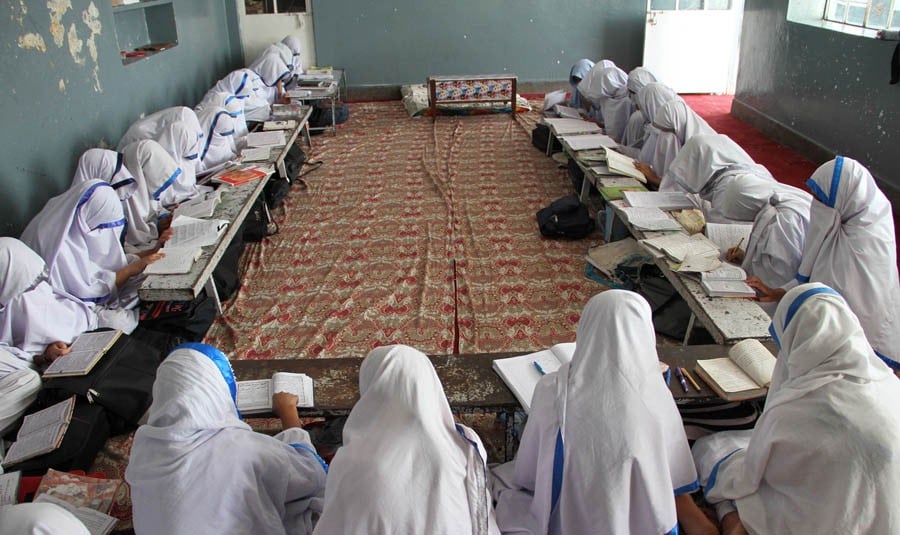
The recent agreement on mainstreaming madrassas between the federal government and the Ittehad-e-Tanzeemat-e-Madaris Pakistan has now reached the implementation stage

Pakistan is finally making headway on its pledge to bring more than 30,000 madrassas - home to some 2.5 million students - into the mainstream. Earlier this month, the federal government formally brought the seminaries under the purview of the Ministry of Federal Education and Federal Training. Previously, these were the responsibility of the Ministry of Religious Affairs.
The agreement, concluded with the Ittehad-e-Tanzeemat-e-Madaris Pakistan (ITMP), an alliance of madrassa boards representing five schools of thought, is the result of months of negotiations. Army Chief Gen Qamar Javed Bajwa also played his part; visiting ITMP leaders twice in recent months to press home the benefits of reform. He also hosted at General Headquarters 13 ITMP students, including four girls, who had scored top marks in the intermediate exams.
The terms of the accord provide that all madrassas operating in the country register with the Education ministry, which will open 12 facilitation centres nationwide towards this end. Failure to comply will lead to closure and a bar on opening bank accounts. All seminaries have agreed to incorporate contemporary subjects into their curricula. In return, the government will expediate foreign students with their visas on the understanding that they do not exceed the maximum limit of nine years.
Mainstreaming madrassas is not a new idea. Successive regimes - both civilian and military - had tried their hand at regulation but to little avail. Mainly because of severe pressure from Islamist groups that rejected any reform agenda as a western conspiracy aimed at diminishing Islam. Yet reports confirm that at least one of the London bombers had visited a seminary some 20 kilometres from Lahore that had links with a banned militant outfit. Thus Pakistan faced increased international pressure to monitor all religious schools and sever any ties to militancy. President General Pervez Musharraf acted accordingly; ordering the expulsion of all foreign students. But madrassa leaders of all sects responded by establishing the ITMP in 2005 to thwart the state’s efforts. Allegations of seminaries promoting radical ideologies and being in the pocket of certain terrorist networks have continued.
Fast-forward to January 2015 and the National Action Plan (NAP) on terrorism was implemented. It received non-partisan support following the deadly terrorist attack on the Army Public School (APS) the previous month; killing more than 150 school children. One of NAP’s 21 objectives pertains to the registration and regulation of madrassas. Provincial governments have completed geo-tagging (data collection on location and size) of most seminaries to assist law enforcement agencies in surveillance. But up until now, the state had not taken any concrete steps on the ground towards this end.
Muhammad Israr Madani, an Islamabad-based expert on religious affairs, is satisfied with the government’s current efforts on madrassa reforms. "It seems the government is serious this time around."
"We had recommended to the government to avoid registering the madrassas on the basis of sect. We told them to formulate a uniform policy that would help reduce sectarian differences in future," says Madari, who attended a meeting with the education ministry on Sep 12. "The government has accepted our recommendation."
He stresses on the need to view reforms beyond the frame of terrorism. "In past, the governments, various ministries and departments, such as religious affairs, used to deal with the madrassa affairs. This time, the education ministry is dealing with the issue. It’s a good decision," Madani tells The News on Sunday.
Some researchers claim that there were no more than 150 madrassas in the geographical landmass that formed Pakistan in 1947. However, records available with the education ministries put the total at 247 for the same period. However, 1955-1960 saw the establishment of four madrassa federations; each aligning themselves with particular sects and school of thoughts, such as Deobandi, Barelvi, Shia and Ahle-Hadith. These set up new seminaries and incorporated into the syllabus religious interpretations in accordance with their particular philosophy. The Jammat-e-Islami (JI), the country’s key Islamist party, established its own madrassa federation in 1983. Presently, most seminaries are registered with these five bodies; which are responsible for setting the syllabus, administering exams, issuing degrees and guaranteeing educational standards.
According to various reports citing statistics compiled by various security agencies and madrassa boards: the total number of seminary students is 4.1 million. Precise numbers are impossible to verify, though, as most institutions operate independently of direct government supervision.
Among them are the 2 million students studying in 15,375 madrassas affiliated with the Wafaq ul Madaris Al-Arabia Pakistan; the largest madrassa education board aligned with the Deobandi school of thoughts. Similarly, some 1.3 million students have been studying in 9,616 madrassas associate d with Tanzeem al-Madaris; reflecting the Barelvi school of thought. And additional 40,000 students are studying in 1,400 madrassas belonging to Wafaq al-Madaris al-Salafi; a board representing the Ahle-Hadith school of thought. Elsewhere, 550 madrassas are under the umbrella of Wafaq al-Madaris; a Shia madrassa federation that boasts a student body of 19,000. Then there is the Rabta al-Madaris al-Islamia; linked to the JI, which runs 1,300 seminaries across the country. Besides these five federations, over 9,000 madrassas operate independently or else fall under the domain of smaller boards. Almost all of these madrassas are privately funded and fall outside of state control.
The task of mainstreaming madrassas is not any easy one.